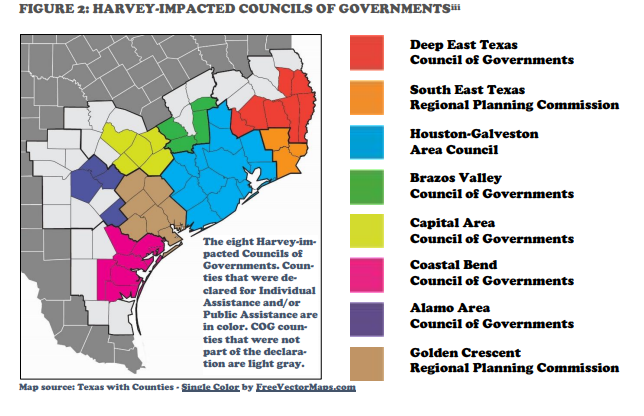Recovering from Harvey: EDA Leads Coordination of Federal Resources

Texas Council of Governments worked with EDA to create regionally-specific workshops for recovery coordination
Click image for larger version.
Hurricane Harvey hit Texas and Louisiana in August of 2017, bringing category 4 winds and catastrophic flooding along the coastline, primarily affecting Rockport, Houston, and Beaumont. The devastating aftermath of the hurricane included the loss of close to 100 lives and more than $125 billion in damage to homes, businesses, and critical infrastructure.
The impacted region is approximately 300 miles long and 100 miles wide and included urban metropolitan areas, agricultural communities, retirement communities, and tourism-dependent coastal areas. More than half of the most-heavily impacted counties were economically distressed prior to Hurricane Harvey.
In the wake of the hurricane, a presidential disaster declaration was issued and EDA began coordinating economic recovery efforts across the federal government in accordance with the National Disaster Recovery Framework. EDA joined FEMA and local and state leaders in developing a Recovery Support Strategy (RSS), specifying critical needs and remaining vulnerabilities for the impacted communities on the Texas and Louisiana coasts.
Economic recovery activities continued with eight long-term economic recovery workshops (PDF) to thoroughly understand the needs of the diverse region, including its tourism-dependent coastal cities, flooded farmlands, and large metroplexes. These workshops were jointly developed with the economic recovery team and regional Councils of Governments (COG) and were designed to give local economic recovery stakeholders, such as local or county governments, face-to-face conversations with federal and state agencies that could assist them. These agencies included the U.S. Departments of Labor, Housing and Urban Development, Agriculture and many others, both federal and state.
“The workshop spotlighted the reason why EDA plays a key role in our region’s recovery from natural disasters — helping our communities get quick answers about specific projects that will help them become more resilient and restore their local economies,” said Chuck Wemple, Chief Executive Officer Houston-Galveston Area Council. “EDA leads the way on convening the entire spectrum of state and federal funding partners. We had a fantastic turnout — from small towns and rural counties to major cities and our largest counties.”
EDA’s ability to coordinate and deliver resources to disaster-impacted communities is illustrated by its quick and effective approach to economic recovery after Hurricane Harvey. The workshops alone served more than 300 community leaders from the public, private, and nonprofit sectors and connected these groups with over $6.4 billion in state and federal recovery funding. To those effected in the community, this coordination was key to rebuilding and becoming more resilient in the face of future disasters. Additionally, EDA continued to serve these communities with further disaster recovery grants and resource coordination.
For more on how EDA successfully supports community-led disaster recovery and resiliency efforts, please visit our EDA and Disaster Recovery webpage.
Tags: Disaster








